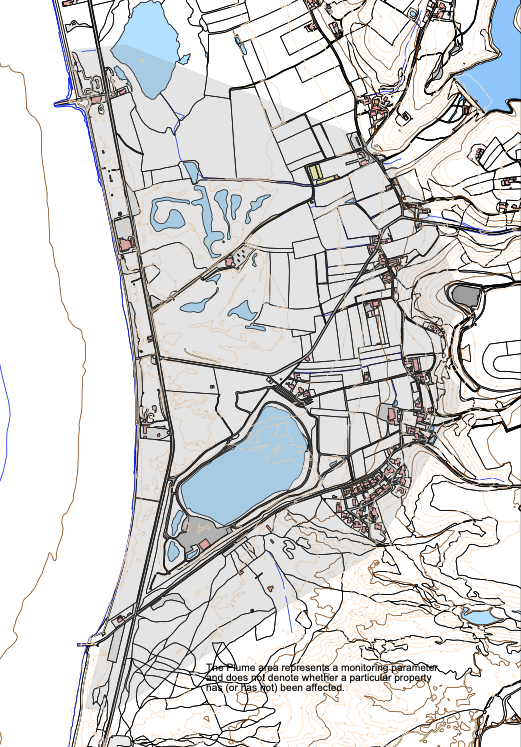

Some people living below the Airport runway are continuing to fall very seriously ill because of chemicals used in firefighting foam, according to one islander campaigning for help from the Government.
Sarah Simon suffers from skin, thyroid and autoimmune disorders, as well as debilitating joint and nerve pain, and has been campaigning for action from the Government for over a decade.
After failing to get what she deems to be a satisfactory response, she has now had her own blood tested to show the levels of PFOS in her body.
She claims that 90% of men living on her road - Route du Val de la Mare du Sud, which runs from the bottom of Mont à la Brune to Jubilee Hill - have suffered kidney, liver and bladder conditions, including cancer, and the same percentage of women have suffered from similar conditions to her own.
Others, she believes, have died prematurely due to illnesses that have been linked to ‘PFOS’ poisoning, including kidney failure and liver disease.
Recently, she has recently drawn strength from a film, based on a true story, about one man’s fight against a corporate giant that was polluting water supplies in the US.
Dark Waters tells the story of a lawyer who fights a successful campaign against Du Pont, after the company contaminated a town with an unregulated chemical called PFOA and then attempted to cover its tracks.
Pictured: Sarah Simon has been inspired by the 2019 film Dark Waters, which tells the true story of one man's fight for justice for victims of chemical poisoning.
A chemical which is part of the same family, called PFOS, was an ingredient in a type of firefighting foam that was sprayed at the Airport for many years, until it was discovered that groundwater supplies in the area had become contaminated with chemicals in the foam that could damage people’s health.
Last year, an official report found that trace levels of PFOS and PFOA were identified in the majority of private water supplies sampled across the island. These were deemed safe, but the report added that stream levels around the western St. Peter/St. Brelade border had higher levels and further testing was required.
But Miss Simon believes that the Government should be focusing on the effects of PFOS in humans and animals rather than just water supplies. She also believes that the toxin accumulates in the body so water samples fail to indicate the true cost to health.
And after her calls for the Government to conduct toxicology testing were rejected, she has taken blood samples of herself, family and neighbours and sent them to specialist laboratories for testing.
The results, she believes, provide conclusive proof that PFOS continues to poison local residents. A sample of her own blood she took in February this year and analysed by a laboratory in Germany was found to contain PFOS levels of 10.1 parts per billion - double the level considered ‘healthy’.
A family member, who has suffered from acute spinal pain and had to have his gallbladder removed, had a PFOS level of 225.25 parts per billion - 45 times over the safe limit.
The family’s black Labrador, who had to be put down last September after an ultrasound showed inoperable tumours in her liver and gallbladder, had a blood PFOS level of 8 parts per billion.

Pictured: Bramble, the Simons' family dog, who was put down last September aged 8, after inoperable tumours were found in her liver and gallbladder.
Miss Simon said: “My health has steadily been declining for years and two years ago I realised not only myself but also my family and many residents in the plume area had been suffering health effects due to unwittingly ingesting PFOS in their water supplies.
“By taking the initiative and taking blood samples myself, I have found evidence that residents who drank contaminated groundwater show levels of PFOS present in their bodies years after their initial exposure.
“The Government and its medical officers continue to deny any link with levels of chemicals and their associated health risks. They continue to deny those residents any support or provide access to medical professionals who may be able to help them understand the consequences of what they have been exposed to.
“Local GPs also need to be made better aware of the impact of PFOS on the body, especially when patients develop conditions that have been associated with PFOS poisoning.
“I strongly believe that residents of Val de la Mare have died as a direct consequence of ingesting PFOS in their drinking water. I hope that the Government will finally wake up and commission a public inquiry to establish the extent of the problem.”
Pictured: Sarah Simon has lived her whole life in St. Ouen's Bay, close to the western end of the runway.
Environment Minister John Young, who leads a ‘political group’ looking at PFOS contamination, said: “There is no doubt that PFOS still exists in St. Ouen’s Bay and more work on it is needed, which is why there is funding in the Government Plan for research to identify the extent of the plume, the levels of PFOS and what remedial options we have.
“I am, however, confident that there is no contamination in mains water and any traces that are found in raw water, such as streams, are diluted and treated before it enters the mains supply. What frustrates me, however, is the pace of connecting properties currently using boreholes to mains. Jersey Water want to connect more properties but we need to find the funding to make that happen.
“The obvious time for me is alongside the extension of the main drains network.”
In a statement, Ports of Jersey said: "We have no further comment to make other than confirming that where appropriate, we continue to fulfil our obligations to residents in this area. This includes water testing from potentially affected areas.
"Although the current covid-19 restrictions have impacted this in recent months, another testing process is due to be carried out in the coming weeks. Ports of Jersey has not been involved in or responsible for any personal health testing and again, in terms of a public enquiry, no approach has been made to us by residents as to our potential involvement in this."
The Government has also been contacted for a response on Miss Simon’s call for blood testing and a public inquiry.
Few would disagree that the PFOS issue has been a long and complicated one, which - like asbestos - has its origins in the widespread use of a product that was later found to be harmful.
When the contamination came to light in the early 90s, the Harbours and Airport Committee agreed to pay for affected properties in the ‘plume area’ - a half-moon area curving out from the western end of the runway to St. Ouen’s Pond to the north and Le Braye in the south - to be connected to mains water. They also paid water rates, provided bottled water and continued to test water sources for levels of PFOS.

Pictured: An official map of the PFOS 'plume area', which covers a sizeable part of St. Ouen's Bay.
In 2004, the States also struck a deal with 3M, the manufacturer of the firefighting foam, which resulted in it paying £2.6m, which was used to clear up and rebuild the Airport firefighting training ground to the northwest of the runway, which had been the source of the contamination in the first place.
When Ports of Jersey was formed as an incorporated company in 2015, it agreed to continue to connect homes, provide bottled water and pay water rates, until sources were declared safe or it could reach legally binding settlements with residents. This process continues.
The Government, however, retained responsibility for all health-related matters and policy decisions.
In December 2018, a private borehole to the north of the Airport, and outside of the plume, was tested for PFOS at the request of its owner and traces of the chemical (and the associated PFOA) were found.
This prompted Environment Minister John Young to form a PFOS ‘political group’, supported by officers, to investigate the matter further. Last year, the group published an interim report which made 18 recommendations, including that people with boreholes, island-wide, should get them tested regularly. It also concluded that mains water was safe to drink.
PFOS is part of a family of chemicals known as PFAS (Perfluoroalkyl and Polyfluoroalkyl Substances) which are a large and complex group of manufactured chemicals widely used to make various everyday products, such as food packaging.
Perfluorooctane sulfonate (PFOS) has been used in the semiconductor and photographic industries, as well as in firefighting foam. It has also been widely used as a protective heat-resistant coating for carpets and textiles. Its sister chemical perfluorooctanoic acid (PFOA) is mainly used in electronics and non-stick cookware and used to be a component of Teflon.
The PFAS family is extremely stable when heated and very difficult to break down naturally. Principally manufactured by 3M, their production stopped in 2002 when scientific reports highlighted their potential risks to human health and the environment. Last May, following a UN conference, their production and use were banned worldwide.
Comments
Comments on this story express the views of the commentator only, not Bailiwick Publishing. We are unable to guarantee the accuracy of any of those comments.